One of the advantages of ocean bottom seismic data is combining hydrophone and vertical geophone data for ghost reflection attenuation. However, when the seafloor is rough and rugged, the scattered shear wave noise will contaminate the geophone data and strongly affect the image quality. The conventional workflow for wavefield separation includes applying shear wave denoise on geophone data first, then combining geophone and hydrophone data for P/Z matching and upgoing/downgoing wavefield separation. In this paper, we propose a new approach that can achieve denoising and matching simultaneously by local attribute matching in the curvelet domain. The proposed method makes use of local dip and scale information to conduct local attribute matching for noise suppression and P/Z matching. This method is applied to real dataset examples for validation. Results show that the new method can successfully suppress the noise with very limited signal leakage. Upgoing wavefield migration results are also provided to prove the P/Z matching was performed effectively. The image quality is significantly improved when compared with the original hydrophone migration image.
Technical Library

